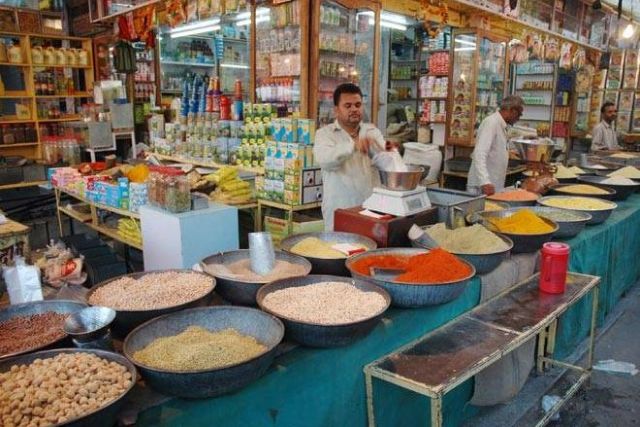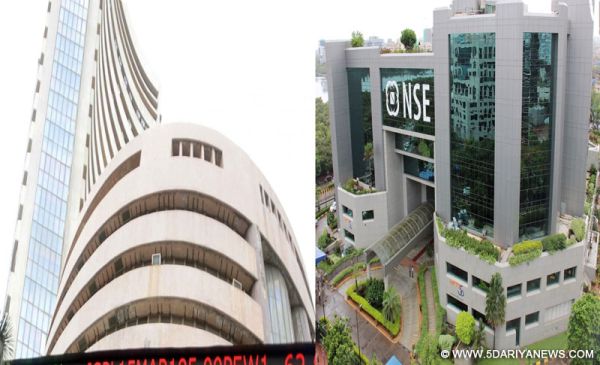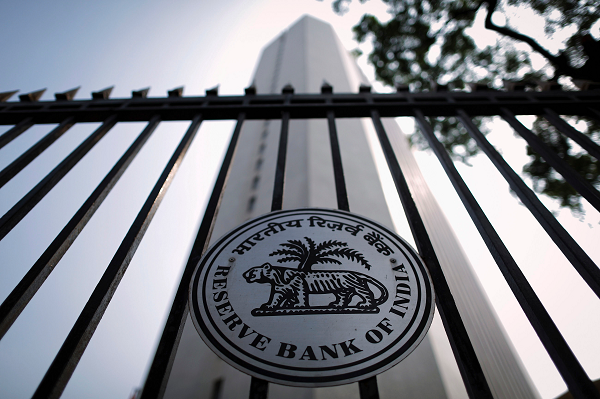
by admin | May 25, 2021 | Business, Commodities, Commodities News, Economy, Markets, News, SMEs
 New Delhi : Retail inflation in India touched the 5 per cent mark in June, compared to 4.87 per cent in May, even as industrial output in May grew at 3.2 per cent over the same month last year but declined as compared to rise of 4.9 per cent in April mainly on account of a decline in manufacturing, official data showed on Thursday.
New Delhi : Retail inflation in India touched the 5 per cent mark in June, compared to 4.87 per cent in May, even as industrial output in May grew at 3.2 per cent over the same month last year but declined as compared to rise of 4.9 per cent in April mainly on account of a decline in manufacturing, official data showed on Thursday.
As per data released by the Central Statistics Office (CSO), the average annual rate of inflation as per the consumer price index (CPI) in June last year was 1.46 per cent.
The consumer food price index (CFPI) in June at 2.91 per cent, however, softened as compared to the 3.10 per cent of the previous month. The inflation in vegetables dropped to 7.8 per cent from 8.04 per cent in the previous month.
The CPI for the ‘fuel and light’ category rose to 7.14 per cent in June, from 5.8 per cent in May.
The higher inflation last month comes in the backdrop of rising global crude oil prices which have been ruling at over $75 a barrel.
Breaking the cycle of interest rate cuts begun in January 2015, the Reserve Bank of India (RBI), at its last monetary policy review in June, raised its repo rate by 25 basis points to 6.25 per cent citing inflationary concerns.
It also revised upwards its inflation projection to 4.8-4.9 per cent for the first half of the current fiscal.
The fall in the Index of Industrial Production in May was caused by a sharp slowing in the growth of the manufacturing sector which registered a growth of 2.8 per cent, as compared to 5.2 per cent in April.
“The industry group ‘Other manufacturing’ has shown the highest negative growth of (-) 31.9 percent followed by (-) 15.6 percent in ‘Manufacture of tobacco products’ and (-) 12.8 percent in ‘manufacture of wearing apparel’,” a CSO statement said.
“The industry group ‘Manufacture of computer, electronic and optical products’ has shown the highest positive growth of 27.0 per cent followed by 21.1 percent in ‘Manufacture of motor vehicles, trailers and semi-trailers’ and 13.2 percent in ‘Manufacture of furniture’.”
Mining output in May at 5.7 per cent in May improved marginally over the 5.1 per cent in April.
Electricity production in the month under consideration rose to 4.2 per cent over the 2.1 per cent in April.
The cumulative IIP growth for the period April-May 2018 over the corresponding period of the previous year stands at 4 per cent, the statement added.
The IIP for April has been revised to 4.8 per cent, from the earlier figure of 4.9 per cent.
Commenting on the IIP data, Deloitte India Lead Economist Anis Chakravarty said in a statement: “The recent easing came largely on the back of manufacturing, while improvements were made across mining and electricity. That said, the movement in manufacturing remains largely steady which bodes well for economic growth, especially when the economy remains at risk from global changes.”
“A clear positive was on food price momentum that remained muted… Although core remains elevated that may keep RBI on guard. We have not yet removed the ‘risk’ of one more rate hike,” said Yes Bank Group President Shubhada Rao.
—IANS

by admin | May 25, 2021 | Economy, Markets, News
 Mumbai : The key Indian equity indices on Monday witnessed the biggest intra-day gains in around two years with the benchmark BSE Sensex index surging by over 600 points and the Nifty50 of the National Stock Exchange (NSE) by almost 200 points.
Mumbai : The key Indian equity indices on Monday witnessed the biggest intra-day gains in around two years with the benchmark BSE Sensex index surging by over 600 points and the Nifty50 of the National Stock Exchange (NSE) by almost 200 points.
According to market observers, across-the-board buying, as well as positive cues from the global markets on easing trade war fears and hopes of easing inflation in the Consumer Price Index (CPI) data at home slated for release after market hours, lifted the indices by gains last seen in March 2016.
On the NSE, the wider Nifty50 edged higher by 194.55 points, or 1.90 per cent, to close trade at 10,421.40 points.
The barometer 30-scrip Sensitive Index (Sensex) closed at 33,917.94 points — up 610.80 points, or 1.83 per cent, from the previous session’s close.
The Sensex touched a high of 33,962.48 points and a low of 33,468.16 points during the intra-day trade.
However, the BSE market breadth remained tilted to the bearish with 1,370 declines and 1,346 advances.
“Markets rallied sharply today with the Nifty breaking out of the 10,444 resistance in the process. The gains came on the back of positive global equity markets as international trade-war concerns took a backseat to economic optimism following a stronger US jobs report released over the weekend,” Deepak Jasani, Head – Retail Research, HDFC Securities, told IANS.
“Gains were led by ITC, HDFC and Reliance Industries. Broad market indices like the BSE mid-cap and small-cap indices gained less, thereby underperforming the main indices,” Jasani added.
In terms of the broader markets, the S&P BSE mid-cap index edged higher by 0.76 per cent and the small-cap index by 0.56 per cent.
Vinod Nair, Head of Research, Geojit Financial Services, said: “Firm global cues and expectation of ease in domestic inflation to 4.74 per cent excited investors to utilise the bargain opportunity.”
“Investors are positive on blue chips on expectation of faster recovery, however, mid and small cap witnessed reluctance due to high valuation,” Nair said.
On the currency front, the Indian rupee strengthened by 13 paise to close at 65.04 against the US dollar from its last week’s close at 65.17.
Provisional data with the exchanges showed that foreign institutional investors turned net buyers and purchased scrips worth Rs 374.65 crore. However, domestic institutional investors sold stocks worth Rs 464.59 crore.
All the 19 sub-indices of the BSE closed with gains led by the S&P BSE banking index, which escalated by 437.70 points.
It was followed by the auto (up 335.17 points), metal (up 325.30 points), oil and gas (up 321.28 points), capital goods (up 228.70 points) and FMCG (up 219.37 points) indices.
Major Sensex gainers on Monday were: Bharti Airtel, up 4.68 per cent at Rs 420.75; NTPC, up 4.33 per cent at Rs 171; ITC, up 4.09 per cent at Rs 270; Tata Motors, up 3.07 per cent at Rs 352.20; and Tata Steel, up 2.82 per cent at Rs 622.70.
The Sensex losers were: Coal India, down 2.26 per cent at Rs 297.80 and State Bank of India, down 0.12 per cent at Rs 252.85.
—IANS

by admin | May 25, 2021 | Banking, Economy, Markets, News
 New Delhi : Continuing rise in food and fuel prices pushed India’s annual retail inflation rate over the five per cent-mark in December, official data showed on Friday, putting paid to hopes of an interest rate cut by the RBI in the near future.
New Delhi : Continuing rise in food and fuel prices pushed India’s annual retail inflation rate over the five per cent-mark in December, official data showed on Friday, putting paid to hopes of an interest rate cut by the RBI in the near future.
According to the data furnished by the Ministry of Statistics and Programme Implementation, December’s consumer price index (CPI) inflation rose to 5.21 per cent from 4.88 per cent in November.
On a year-on-year (YoY) basis, the CPI inflation last month was higher than the 3.41 per cent recorded in December 2016.
The Consumer food price index (CFPI) in December stood at 4.96 per cent compared to the 4.42 per cent of November 2017.
The annual CPI in rural areas in December ruled higher at 5.27 per cent, while in urban India it rose by 5.09 per cent.
Retail inflation on a YoY basis edged higher due to a rise in the prices of food items like vegetables, milk-based products, eggs, meat and fish.
The data showed that vegetables in December became costly by a whopping 29.13 per cent, while prices of milk-based products rose by 4.37 per cent.
Other notable categories such as cereals became dearer by 2.57 per cent and meat and fish recorded a rise of 4.22 per cent.
The sub-category of food and beverages during the month under consideration recorded a rise of 4.85 per cent over the same period last year.
Among non-food categories, the “fuel and light” segment’s inflation rate accelerated to 7.9 per cent in October.
Earlier this month, Finance Minister had told Parliament that the inflation had increased owing to a seasonal rise in vegetable prices and the higher house rent allowances disbursed to government employees under the 7th Pay Commission recommendations.
Inflationary risks forced the Reserve Bank of India (RBI) to hold its key lending rate unchanged for the third time in a succession at 6 per cent in its penultimate bi-monthly monetary policy review of the fiscal last month.
Announcing the decision of the monetary policy committee (MPC), the RBI said inflation is expected to range around 4.3-4.7 per cent in the second half of the fiscal, including the impact of increase in house rent allowance.
The central bank said “two of the key factors determining the cost of living conditions and inflation expectations — food and fuel inflation — edged up in November”.
“The decision of the MPC is consistent with a neutral stance of monetary policy in consonance with the objective of achieving the medium-term target for consumer price index inflation of 4 per cent within a band of +/- 2 per cent, while supporting growth,” an RBI statement said.
—IANS

by admin | May 25, 2021 | Banking, Corporate, Corporate Governance, Finance, News
 Mumbai : The Reserve Bank of India (RBI) is expected to keep its key interest rate unchanged in its next monetary policy review on Wednesday, in view of the consumer price index (CPI) inflation in August shooting up to 3.36 per cent, according to latest official data.
Mumbai : The Reserve Bank of India (RBI) is expected to keep its key interest rate unchanged in its next monetary policy review on Wednesday, in view of the consumer price index (CPI) inflation in August shooting up to 3.36 per cent, according to latest official data.
While core inflation in August rose to 4.6 per cent, high food and fuel prices pushed wholesale inflation at 3.24 per cent, to nearly double of that over the previous month.
The RBI’s monetary policy committee (MPC), which will deliberate over two days here from Tuesday to decide on the fourth policy review of the fiscal, has the mandate to target an annual retail inflation rate of 4 per cent, with a band of 2 per cent in either direction.
In the previous bi-monthly review in August, subdued inflation and demand had prompted the central bank to reduce its repurchase rate, or the short-term lending rate for commercial banks, by 25 basis points (bps) to 6 per cent from 6.25 per cent.
State-run State Bank of India (SBI), in a report titled “RBI caught in a bind: Expect status quo on October 4, 2017”, said the apex bank faced a difficult decision on cutting its lending rate.
“On the eve of the forthcoming monetary and credit policy, the central bank is stuck in a conundrum of low growth, mild inflation, saving financialisation and external uncertainties. This will make the job difficult for the RBI on October 4,” the SBI Ecowrap report said.
“The obvious question that arises is choosing between (a) the move towards the 4 per cent inflation target swiftly, or (b) staying in the inflation band,” said SBI Chief Economic Adviser Soumya Kanti Ghosh.
“In hindsight, if the central bank moves towards the 4 per cent target in January 2018 as was suggested earlier, there would be limited room for rate cut in forthcoming policies.”
The reduction in August came after four consecutive policy reviews in which the RBI had maintained status quo on its repo, or short-term lending rate, since the reduction by 25 bps to 6.25 per cent in October 2016.
Announcing the August review, the RBI said: “Noting, however, that the trajectory of inflation in the baseline projection is expected to rise from current lows, the MPC decided to keep the policy stance neutral and to watch incoming data. The MPC remains focused on its commitment to keeping headline inflation close to four per cent on a durable basis.”
Domestic credit rating agency ICRA also discounted the possibility of an RBI rate cut.
“We do not expect a rate cut in the upcoming policy review as consumer price index (CPI) inflation is expected to chart an upward trajectory over the coming months, and print between 4.5 per cent and 5 per cent in March 2018,” ICRA MD Naresh Takkar said in a report earlier this week.
Instead, the drop in GDP growth during the first quarter, has provoked strident Arate cut calls from industry, which wants urgent steps to revive private investments.
Pulled down by sluggish manufacturing, growth in the Indian economy, during April to June, fell to 5.7 per cent, clocking the lowest GDP growth rate under the Narendra Modi dispensation.
According to the American financial services firm Morgan Stanley, the RBI is expected to hold rates while maintaining its neutral policy stance.
“We expect the RBI to stay on hold at the upcoming meeting as rising incoming inflation and projections of further acceleration in inflation ahead will mean that there would be limited space for further easing,” Morgan Stanley said in a research note.
The SBI report also pointed to external challenges like rising geopolitical tensions, and the hardening of commodity and crude oil prices. In mid-September, petrol rates here, for instance, Atouched their highest level since Modi assumed office three years ago.
“In particular, the external environment looks a little bit wobbly compared to what it was at the beginning of 2017,” it said.
“No wonder, the rupee is currently witnessing depreciation pressures,” the report added.
The rupee has recently come under pressure owing to volatile capital flows and the country’s widening current account deficit.
—IANS

 New Delhi : Retail inflation in India touched the 5 per cent mark in June, compared to 4.87 per cent in May, even as industrial output in May grew at 3.2 per cent over the same month last year but declined as compared to rise of 4.9 per cent in April mainly on account of a decline in manufacturing, official data showed on Thursday.
New Delhi : Retail inflation in India touched the 5 per cent mark in June, compared to 4.87 per cent in May, even as industrial output in May grew at 3.2 per cent over the same month last year but declined as compared to rise of 4.9 per cent in April mainly on account of a decline in manufacturing, official data showed on Thursday.

